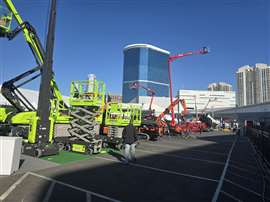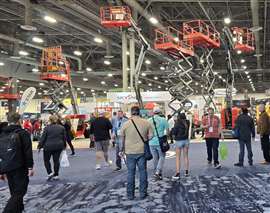What did the ARA Show tell us about the North American rental market?
20 February 2025
 An outside shot of the ARA Show 2025. Photo: KHL Group
An outside shot of the ARA Show 2025. Photo: KHL Group
With the dust now settled on the 2025 edition of the ARA Show, attendees and exhibitors are reflecting on an event that offered more than just a showcase of the latest in equipment, technology, and services.
Beyond the vast displays, the show provided a snapshot of the North American rental industry’s current landscape and its outlook for the year ahead.
With key insights from the American Rental Association’s updated forecast, OEM perspectives on demand and investment trends, and a growing emphasis on technology, the ARA Show painted a picture of both optimism and caution for the future of the equipment rental sector.
On the first day, show organisers the American Rental Association (ARA) released its updated forecast, which revealed that the US construction and general tool rental industry concluded 2024 with $83.3 billion in revenue, marking an 8% increase over 2023.
It said that the growth reflects the ongoing strength of the sector, and the industry is expected to maintain positive momentum, with a projected 5.2% growth in 2025, bringing the total to $87.5 billion.
However, looking further ahead, growth rates are anticipated to moderate, with projections of 4.1% growth in 2026 and 4% in 2027.
These forecasts align with expectations of slower investment in both the construction and general tool industries in the coming years, the ARA said.
Scott Hazelton, managing director at S&P Global, said, “Economic uncertainty and relatively high financing costs, underscored by today’s Fed decision, weigh on the outlook for investment.
“However, this is little risk of a serious downturn, and equipment rental can gain penetration in uncertain times. Our equipment rental outlook for 2025 has been lowered from our view last quarter, however, we still project equipment rental growth at about twice the rate of real GDP and inflation.”
Meanwhile, the penetration rate for construction and industrial equipment (CIE) rentals increased for the fourth consecutive year, reaching 57% in 2024, the highest level of penetration in the industry since before the pandemic.
The outlook for Canada
In Canada, the construction and general tool rental industry saw positive results, finishing 2024 with a $5.73 billion revenue, reflecting a 6.1% growth over the previous year.
The Canadian market is projected to continue its upward trajectory, with a forecasted 3.7% growth in 2025, bringing the total to $5.95 billion. Looking further ahead, growth in the Canadian rental market is projected to reach 7.2% in 2026 and 6.7% in 2027.
Tom Doyle, ARA vice president of program development, said, “Equipment rental penetration hit a record in the past quarter as rental customers continue to accept the solutions provided by rental companies.
“For 2025, while the forecast calls for growth in the equipment segment, that growth softens. Our quarterly ARA member surveys confirmed they expect growth in Q1 of 2025.”
The ARA also shared the significant economic impact of the equipment rental industry, which directly, indirectly, or through induced effects, supports 666,000 jobs in the U.S. The sector contributes $47.4 billion in wages and adds $115 billion to the GDP.
Mostly positive outlook for rental demand
While in Las Vegas, IRN put four questions to exhibiting companies, each with the aim of gauging how confident they are for 2025 and also to find out how rental demand is holding up from the perspective of OEMs.
 Skyjack’s display at the 2025 ARA Show in Las Vegas. (Photo: KHL Group)
Skyjack’s display at the 2025 ARA Show in Las Vegas. (Photo: KHL Group)
In this metric, which covers whether OEMs expect demand to be better, stable or worse than 2024 (although not necessarily in terms of spend. See section below for that), we find that companies remain mostly positive for the year ahead.
42% of responses expect demand to be better in 2025 than it was in 2024. Add that to the 45% that said they expect demand to be stable this year and it gives you some idea as to the confidence of suppliers.
One respondent noted that an influx of projects, coupled with the culture of renting becoming more prevelant, means that they see demand not only increasing for the year ahead, but also for the coming years.
On the other hand, just 13% of responses said they expect demand from rental companies to decrease this year. One anonymous respondent told IRN that although there could be more projects on the horizon, the uncertainty surrounding President Trump’s plans has resulted in some caution.
However, the same respondent said that as the year goes on, they still expect to see some improvement in demand as that apprehension declines.
CapEx expectations for 2025
How about investment sentiment for the year ahead? In recent years industry CapEx has been historically high, but again, in the context of the industry playing catch up after the pandemic that is probably not a surprise.
Looking ahead to this year, some 56% of OEMs are anticipating higher spend from their rental customers in 2025, with 38% expecting no change and 6% expecting spending to decrease.
On the positive side, one OEM said that the new administration could bring about more confidence and demand in the form of projects.
Another added that some companies operating in more specialised equipment will continue to invest and potentially add more to their specialty portfolio.
That sentiment was echoed by another respondent, who said that earthmoving equipment could stabalise, but investment in more niche products could increase.
On the other side of the coin, one respondent that expects a decrease said that although on the face of it a drop in spending may be seen as a negative, previous high spend means that companies are entering a phase of stabilisation.
Investment in alternative power
In previous visits to the ARA Show, there seems to have been a view of ‘wait and see’ regarding the transition to hybrid, electric and hydrogen powered equipment.
Hardly surprising given that the regulations in the US are arguably not as stringent as those in Europe. In fact, one respondent said that they can’t see a future where adoption of alternative power increases unless there is some form of push from the new administration.
Another pointed towards Trump’s strance on diesel, with some of his executive orders designed to benefit gas-powered vehicles.
 Foto: AdobeStock / Scharfsinn86
Foto: AdobeStock / Scharfsinn86
That stance is reflected in the survey results, with just 21% predicting an increase in spend on alternative-powered equipment this year.
The majority of responses (57%) expect no change and 14% expect investment in this metric to decrease.
So, while there is clearly some apprehension amidst a lack of regulations, it doesn’t seem to be impacting sentiment either positively or negatively.
Interestingly, one person that spoke with IRN said they had walked around the show, and had been surprised at the lack of electric equipment on show.
The role of tech in efficiency
The skills shortage, productivity and efficiency are all common challenges that rental companies have to overcome.
To do so, many are turning their attentions to technology, whether that be internal or external systems.
IoT, remote monitoring and of course the growing adoption of Artificial Intelligence are some of the latest trends, and the survey reveals that the demand in this space in North America is as far down the line as it is in other regions.
73% of responses here expect more rental companies to invest in equipment that is smart, or invest in systems for either themselves of their customers.
Surprisingly, the remaining 27% said they expect no change, meaning not one respondent said they expect less demand for technology from rental companies in 2025.
Again, the ARA Show offered a small sample of responses when taking into account the size of the market, but the response here will probably be what many expect.
One respondent pointed towards the number of tech specialists exhibiting at the show as a point of reference to demand, telling IRN that “if you went back 10 years, you wouldn’t have been the same level.”
Another company that doesn’t currently offer tech-enabled equipment said that it is noting an increase in rental customers asking for it, mainly to overcome the productivity puzzle in North America.
Power demand
Despite the survey finding that many rental companies are yet to be convinced on alternative-powered models, there were a number of models on show.
For example, US-based manufacturer Toro added three new electric machines to its portfolio on its stand.
The company said the electric swivel Ultra Buggy e2500-TS is designed to assist with transporting various materials on job sites both indoors and outdoors and will replace multiple wheelbarrow loads or loader trips.
It comes with a 14-cubic-foot carrying capacity, a 2.5 tonne load rating, and up to an eight-hour runtime with its Toro HyperCell Battery System.
IRN was told that its compact 31.5-inch width allows it to navigate tight spaces such as doorways, hallways, small rooms, and gates, while a reinforced track system enables movement over rough terrain and debris while minimising turf disturbance.
The T-handle controls enable crews to operate the machine with minimal training, the company said.
Elsewhere on its stand, Toro also introduced the electric high-lift Ultra Buggy e2500-THL, which it said is designed for material handling tasks requiring height, such as dumping into a 30-yard dumpster.
Its third launch, the eDingo TX 750, is an electric compact utility loader available in both narrow-track and wide-track models.
The company said the machine is designed for various rental applications, including interior construction, demolition, landscaping, and debris clearing.
The eDingo TX 750, which builds on the eDingo 500 model, is also equipped HyperCell Battery System, providing up to eight hours of runtime.
In the larger range, Volvo showcased its 1.8 tonne EC18 Electric compact excavator. Designed for efficiency and sustainability, the unit is powered by a 48V, 20kWh lithium-ion battery.
The EC18 Electric offers an indicative runtime of up to six hours, depending on the application, while charging options are flexible: on-board charging using a 230 VAC 16A power source takes approximately six hours, while off-board charging with a 400 VAC 32A supply reduces the charging time to about 1 hour and 15 minutes.
It also offers zero-tailpipe emissions and reduced noise levels, making it ideal for urban construction and environmentally sensitive areas.
Other specifications include a variable undercarriage width ranging from 995mm to 1,352mm, maximum digging depth between 2,500mm and 2,700mm and a maximum dump height ranging from 2,444mm to 2,588mm.
The machine’s breakout force is rated at 12.9kN, with an arm tear-out force between 6.95kN and 7.95Kn
Meeting rental needs
Meanwhile, Ditch Witch debuted the c3E, the world’s first electric walk-behind trencher.
Designed for ease of use and increased productivity, the c3E is equipped with an advanced electric motor that provides instant torque, enabling operators to trench up to 1,000ft in clay on a single charge.
The company said the c3E comes with intuitive controls and easy start-up features, reducing vibration and mitigating operator fatigue.
These improvements lead to higher productivity, it said, allowing operators to work longer without the strain of traditional equipment.
The machine also regulates trenching speed for smoother, more efficient cuts, ensuring a more effective operation without struggling against the machine.
For rental yard owners, the c3E promises to increase rental frequency, as operators can complete jobs more efficiently, boosting profitability and reducing downtime.
Wacker Neuson launched the articulated RTD-SC4 trench roller and said that it will meet the “critical goals” of rental and contractor customers.
Powered by a 19.8hp (17.7kW) Kohler KDW1003 series diesel engine, the unit is a redesigned version of the company’s first trench roller, launched 30 years ago.
The company said that the RTD-SC4 is built for durability, ease of service, and low maintenance, with a focus on operator experience, productivity, and safety.
Speaking to IRN, Roberto Martinez, director of product management & market development at Wacker Neuson America, noted that while the company’s trench rollers have remained largely unchanged over the years, the RTD-SC4 introduces several upgrades based on rental dealer and operator feedback.
Enhancements include an adjustable drum width from 23.6 to 32 inches, allowing flexibility for different trench applications.
The design has also been simplified, reducing the number of parts, hoses, and connections by more than 30%. A revised hose routing system improves serviceability, lowers downtime, and reduces total cost of ownership.
The new model features a 1,000-hour service interval on the transmission and exciter system.
Additionally, a return-to-center function automatically realigns the machine’s articulation when the steering paddle is released, reducing the need for constant steering adjustments and improving efficiency.
Show debuts
UK-headquartered OEM JCB used the show to unveil updates to its iconic 3CX and 4CX backhoe loaders.
The company, which also celebrated a milestone in backhoe production with a special one-millionth livery, said upgraded to the machines include an enhanced roading performance, a new outer box dipper option for the excavator end, and an upgraded operator-focused cab, all designed to improve efficiency, comfort, and safety on construction sites.
The 3CX and 4CX backhoe loaders feature a new six-speed auto-shift transmission, which enhances roading capabilities, allowing the machines to reach a top speed of nearly 30mph.
The new outer box dipper on the excavator end offers improved weight distribution, making it the optimal solution for thumb mounting.
Elsewhere, a redesigned operator cab now includes a 7-inch display, Bluetooth connectivity, ergonomic joystick controls, and improved visibility through larger mirrors and LED work lights.
Develon exhibited four machines at the show, including the DTL35 compact track loader. Launched last year, the DTL35 compact track loader features 115.3hp (86kW) at 2,400rpm and an operating weight of 12,785lb (5.7kg).
The loader includes a vertical lift configuration, improved hydraulic quick coupler, and ride control for enhanced stability and reduced vibration.
The operator benefits from a spacious, three-foot-wide cab with heated air-suspension seats and intuitive controls.
It also boasts a high-efficiency maintenance design, including a tilting cab for easy engine access.
As well as its range of engines, Vanguard displayed its range of Vanguard Commercial Batteries.
Part of that range was the Vanguard 48V 1.5kWh Swappable Commercial Battery, which offers a nominal voltage of 51.4V and a charge voltage of 58.8V.
It has a nominal capacity of 28.4 Ah and provides a discharge current of 29A. The battery operates in temperatures ranging from -40°C to +60°C during discharge, and 0°C to +45°C for charging.
Designed for durability, it offers up to 1,000 cycles to 80% capacity. The battery features CANJ1939 communication protocols and weighs 26 lbs. It comes with an 8-year commercial limited warranty.
STAY CONNECTED



Receive the information you need when you need it through our world-leading magazines, newsletters and daily briefings.
CONNECT WITH THE TEAM







